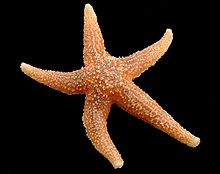| Forcipulatida | |
|---|---|

| |
| Asterias rubens | |
| Scientific classification | |
| Domain: | Eukaryota |
| Kingdom: | Animalia |
| Phylum: | Echinodermata |
| Class: | Asteroidea |
| Superorder: | Forcipulatacea |
| Order: | Forcipulatida |
| Families | |
|
See Text | |
The Forcipulatida are an order of sea stars, containing three families and 49 genera.
Description
Forcipulatids share with the brisingid sea stars distinctive pedicellariae, consisting of a short stalk with three skeletal ossicles. Unlike that group, however, the forcipulatids tend to have more robust bodies. The order includes some well-known species, such as the common starfish, Asterias rubens. This order can be commonly found from North Carolina in the United States all the way to Santos in Brazil.
Phylogeny
The order is divided into three families:
- Family Asteriidae — 39 genera
- Family Heliasteridae — two genera
- Family Zoroasteridae — eight genera
World Register of Marine Species gives another taxonomy, with 7 families and 64 genera:
- Family Asteriidae Gray, 1840
- Family Heliasteridae Viguier, 1878
- Family Pedicellasteridae Perrier, 1884
- Family Pycnopodiidae Fisher, 1928
- Family Stichasteridae Perrier, 1885
- Family Zoroasteridae Sladen, 1889
A 2020 study involving phylogenetic analysis and scanning electron microscopy of the skeleton and ossicles of taxa from the superorder Forcipulatacea recovered Asteriidae, Stichasteridae, Zoroasteridae, and Brisingida as monophyletic.
The extinct family Terminasteridae has also been placed in this order.
See also
References
- Barnes, Robert D. (1982). Invertebrate Zoology. Philadelphia, PA: Holt-Saunders International. p. 948. ISBN 0-03-056747-5.
- Pazoto, C. P., Ventura, C., Duarte, M., & Silva, E. (2018). Genetic variation and population homogeneity of the sea star Coscinasterias tenuispina (Forcipulatida: ASTEROIDEA) on the coast of Rio de Janeiro, Brazil. Latin American Journal of Aquatic Research, 46(2), 355-363. doi:10.3856/vol46-issue2-fulltext-11
- McKnight, D.G. (2006). Marine Fauna of New Zealand: Echinodermata: Asteroidea (sea-stars). 3. Orders Velatida, Spinulosida, Forcipulatida, Brisingida with addenda to Paxillosida, Valvatida. NIWA Biodiversity Memoir 120: 1-187.
- Fau, Marine; Villier, Loïc (2020). "Comparative anatomy and phylogeny of the Forcipulatacea (Echinodermata: Asteroidea): insights from ossicle morphology". Zoological Journal of the Linnean Society. 189 (3): 921–952. doi:10.1093/zoolinnean/zlz127.
- Ewin, Timothy A. M.; Gale, Andrew S. (September 2020). "Asteroids (Echinodermata) from the Barremian (Lower Cretaceous) of the Agadir Basin, west Morocco". Journal of Paleontology. 94 (5): 931–954. doi:10.1017/jpa.2020.20. ISSN 0022-3360.
Further reading
- Mah, C. & D. Foltz. (2011). Molecular Phylogeny of the Forcipulatacea (Asteroidea: Echinodermata): systematics and biogeography. Zoological Journal of the Linnean Society 162(3): 646-660
- Sladen, W.P. (1889). Report on the Asteroidea. Report on the Scientific Results of the Voyage of H.M.S. Challenger during the years 1873-1876, Zoology 30(51): xlii + 893 pages 118 plates.
 | This article about a starfish is a stub. You can help Misplaced Pages by expanding it. |